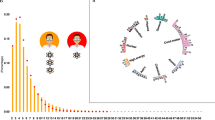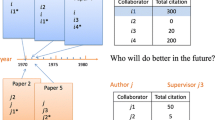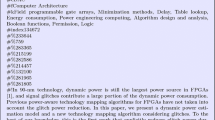Abstract
While some believe that publication and citation scores are key predictors of breakthroughs in science, others claim that people who work at the intersection of scientific communities are more likely to be familiar with selecting and synthesizing alternatives into novel ideas. This paper contributes to this controversy by presenting a longitudinal comparison of highly creative scientists with equally productive researchers. The sample of creative scientists is identified by combining information on science awards and nominations by international peers covering research accomplishments in the mid-1990s. Results suggest that it is not only the sheer quantity of publications that causes scientists to produce creative pieces of work. Rather, their ability to effectively communicate with otherwise disconnected peers and to address a broader work spectrum also enhances their chances to be widely cited and to develop novel ideas.
Similar content being viewed by others
References
Allison, P. D., Waterman, R. P. (2002), Fixed-effects negative binominal regression models, Sociological Methodology, 32: 247–265.
Amabile, T. M. (1996), Creativity in Context, Westview Press, Boulder, Colorado.
Borgatti, S., Everett, M., Freeman, L. (2002), Ucinet 6 for Windows. Software for Social Network Analysis, Analytic Technologies, Natick.
Burt, R. S. (1992), Structural Holes. The Social Structure of Competition, Harvard University Press, London.
Burt, R. S. (2004), Structural holes and good ideas, American Journal of Sociology, 110: 349–399.
Cross, R., Cummings, J. N. (2004), Tie and network correlates of individual performance in knowledge-intensive work, Academy of Management Journal, 47: 928–937.
Heinze, T. (2006), Die Kopplung von Wissenschaft und Wirtschaft. Das Beispiel der Nanotechnologie, Campus, Frankfurt/New York.
Heinze, T., Shapira, P., Senker, J., Kuhlmann, S. (2007), Identifying creative research accomplishments: methodology and results for nanotechnology and human genetics, Scientometrics, 70: 125–152.
Hemlin, S., Allwood, C. M., Martin, B. R. (Eds) (2004), Creative Knowledge Environments. The Influences on Creativity in Research and Innovation, Cheltenham: Edward Elgar.
Hollingsworth, R. (2002), Research Organizations and Major Discoveries in Twenthieth-Century Science: A Case of Excellence in Biomedical Research., WZB Discussion Paper P02-003, Berlin.
Hollingsworth, R. (2004), Institutionalizing excellence in biomedical research: The case of Rockefeller University. In: D. H. Stapleton (Ed.), Creating a Tradition of Biomedical Research. Contributions to the History of the Rockefeller University. Rockefeller University Press, pp. 17–63.
Hullmann, A., Meyer, M. (2003), Publications and patents in nanotechnology. An overview of previous studies and the state of the art, Scientometrics, 58: 507–527.
Lee, S., Bozeman, B. (2005), The impact of research collaboration on scientific productivity, Social Studies of Science, 35: 673–702.
Rodan, S., Galunic, C. (2004), More than network structure: How knowledge heterogeneity influences managerial performance and innovativeness, Strategic Management Journal, 25: 541–562.
Simonton, D. K. (1999), Origins of Genius: Darwinian Perspectives on Creativity, Oxford University Press, New York.
Simonton, D. K. (2004), Creativity in Science: Chance, Logic, Genius, and Zeitgeist, Cambridge University Press, Cambridge.
Sternberg, R. J. (2003), Wisdom, Intelligence, and Creativity Synthesized, Cambridge University Press, Cambridge.
Sternberg, R. J., Ohara, L. A., Lubart, T. I. (1997), Creativity as investment, California Management Review, 40: 8–32.
Weinert, F. E. (2000), Individuelle Kreativität und kollektives Ergebnis, Der Architekt. Zeitschrift des Bundes deutscher Architekten, 48: 24–31.
Whitley, R. (2000), The Intellectual and Social Organization of the Sciences, 2ndedition, Oxford University Press, Oxford.
Author information
Authors and Affiliations
Corresponding author
Rights and permissions
About this article
Cite this article
Heinze, T., Bauer, G. Characterizing creative scientists in nano-S&T: Productivity, multidisciplinarity, and network brokerage in a longitudinal perspective. Scientometrics 70, 811–830 (2007). https://doi.org/10.1007/s11192-007-0313-3
Received:
Issue Date:
DOI: https://doi.org/10.1007/s11192-007-0313-3




